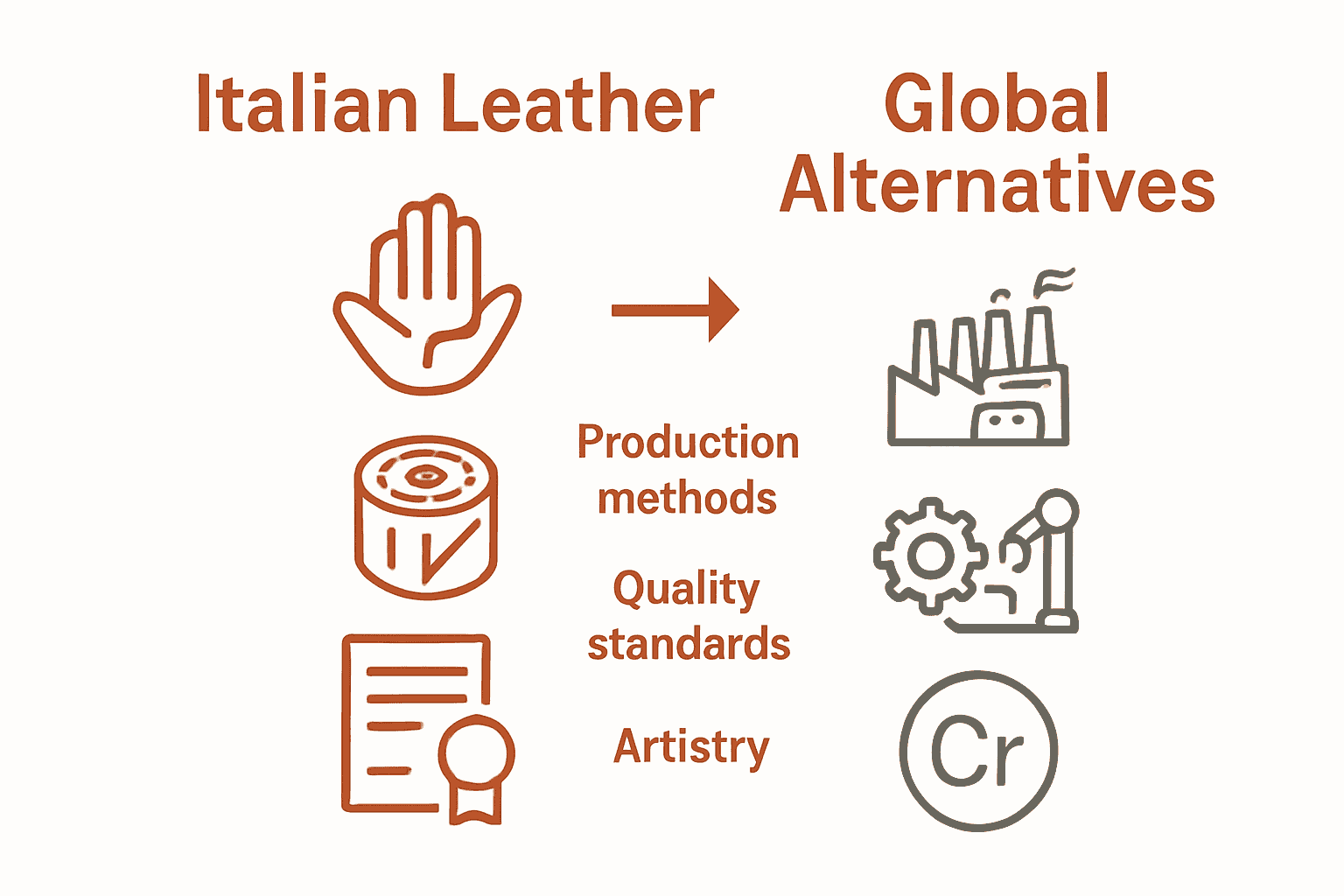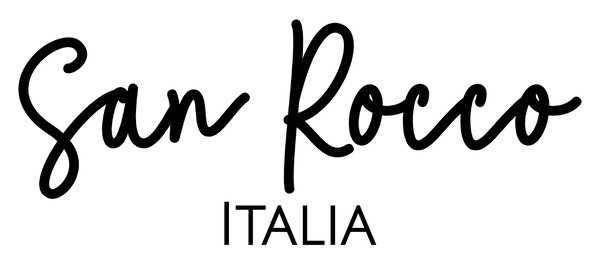
Leather Italy Explained: Heritage, Quality and Craft
Share
Most people are surprised to learn that British designers consistently favour Italian leather for luxury goods, highlighting its unmatched reputation worldwide. This preference speaks volumes about the fine craftsmanship and deep heritage that Italian leather represents. With each piece crafted through methods perfected over centuries, this article reveals how Italian leather stands apart and explains why materials with genuine heritage remain at the heart of the world’s most distinguished creations.
Table of Contents
- Defining Italian Leather And Its Heritage
- Types Of Italian Leather And Their Differences
- Traditional Italian Leather-Making Techniques
- Sourcing, Authenticity, And Labelling Standards
- Ethical, Sustainable, And Quality Considerations
- Comparing Italian Leather To Global Alternatives
Key Takeaways
| Point | Details |
|---|---|
| Heritage of Italian Leather | Italian leather represents centuries of tradition and artisanal craftsmanship, emphasising high-quality materials and techniques that enhance durability and aesthetic appeal. |
| Types of Italian Leather | There is a diverse range of Italian leathers, each with distinct textures and applications, including calfskin, toro, and vacchetta, which cater to various luxury products. |
| Traditional Techniques | Traditional Italian leather-making employs vegetable tanning and hand-finishing, preserving the material’s unique characteristics and promoting environmentally conscious practices. |
| Authenticity Standards | Genuine Italian leather requires stringent verification processes, including transparent documentation and artisanal certification, to ensure quality and authenticity. |
Defining Italian Leather And Its Heritage
Italian leather represents the pinnacle of artisanal craftsmanship, embodying centuries of tradition, skill, and unparalleled quality. According to JD Institute, the heritage of Italian leather is deeply rooted in meticulous techniques that transform raw materials into exquisite products that transcend mere functionality.
Italian leather is distinguished by its exceptional production methods, primarily focusing on full-grain and top-grain leather types. These premium materials undergo rigorous selection and processing, ensuring each piece maintains superior durability, texture, and aesthetic appeal. Artisans carefully choose animal hides, typically from cattle, and employ time-honoured techniques that have been refined over generations.
The hallmark of Italian leather lies not just in its material quality, but in the profound cultural significance attached to its creation. Discover the fascinating journey of Italian leather goods through our comprehensive exploration of its rich historical narrative. From the medieval tanneries of Tuscany to contemporary luxury fashion houses, Italian leather represents more than a material - it embodies a commitment to excellence, artistic expression, and sustainable craftsmanship.
Key characteristics that define authentic Italian leather include:
- Exceptional grain quality
- Meticulous hand-finishing techniques
- Natural, breathable materials
- Resistance to wear and ageing
- Unique patina development over time
Understanding Italian leather means appreciating a living tradition that transforms simple animal hide into wearable art, connecting generations through skill, passion, and unwavering dedication to quality.
Types Of Italian Leather And Their Differences
Italian leather is not a monolithic category but a nuanced world of diverse leather types, each with unique characteristics and specialised applications. Zerow highlights the remarkable variety of Italian leathers, showcasing how different animal hides and processing techniques create distinctive materials suited to various luxury products.
Calfskin leather emerges as a premier choice for high-end fashion, prized for its extraordinary softness and refined grain. Unlike other leather types, calfskin offers an exceptionally smooth texture that feels luxurious against the skin. In contrast, toro leather represents a more robust option, characterised by its thicker structure and enhanced durability, making it ideal for items requiring structural integrity like professional briefcases and heavy-use accessories.
Learn more about the unique properties of different Italian leather types to understand how each variety serves distinct purposes. Vacchetta leather, another remarkable Italian leather type, stands out for its vegetable tanning process, which allows the material to develop a rich, evolving patina over time. This natural ageing process transforms the leather, creating a unique aesthetic that tells a story of craftsmanship and individual use.
Key differences among Italian leather types include:
- Texture variations from ultra-smooth to structured
- Thickness ranging from delicate to robust
- Tanning methods: vegetable vs. chrome
- Colour absorption and development
- Intended use in fashion and accessories
Understanding these nuanced differences empowers discerning consumers to select leather pieces that not only meet their functional needs but also reflect their personal style and appreciation for exceptional craftsmanship.

Traditional Italian Leather-Making Techniques
Traditional Italian leather-making represents an extraordinary fusion of art, science, and generational expertise that transforms raw animal hides into extraordinary materials. BRACCI Leathers exemplifies this intricate process, highlighting the meticulous techniques that distinguish Italian leather craftsmanship from global counterparts.
At the heart of traditional tanning methods lies the vegetable tanning process, a time-honoured technique that produces full aniline and full top-grain hides with unparalleled natural beauty. Unlike industrial chrome tanning, this method preserves the leather’s inherent characteristics, allowing each hide to maintain its unique texture, breathability, and subtle imperfections that tell a rich tactile story. Skilled artisans carefully select tannins extracted from tree bark, chestnuts, and mimosa, creating a natural transformation that respects both material and environment.
Explore the comprehensive guide to Italian leather craftsmanship and discover the nuanced techniques passed down through generations. The process involves multiple intricate stages, each requiring exceptional skill and patience. From initial hide selection to final finishing, every step is performed with surgical precision and artistic sensibility. Artisans assess each hide’s quality, remove imperfections, and apply traditional treatments that enhance the leather’s natural properties.
Key elements of traditional Italian leather-making include:
- Careful hide selection
- Natural vegetable tanning processes
- Hand-finishing techniques
- Preservation of unique hide characteristics
- Environmentally conscious production methods
These time-honoured techniques transform leather from a mere material into a living, breathing testament to Italian craftsmanship - each piece carrying the warmth of human touch and generations of accumulated wisdom.
Sourcing, Authenticity, And Labelling Standards
Italian leather authenticity represents a complex landscape of nuanced regulations and expert verification processes. Senreve highlights the critical challenge facing consumers: leather labels can be profoundly misleading, requiring sophisticated understanding to distinguish genuine Italian craftsmanship from mere marketing claims.
Authentic Italian leather requires comprehensive verification across multiple dimensions. Sourcing standards demand that the entire production process - from hide selection to final crafting - occurs within specific Italian regions, typically Tuscany, which has been renowned for leather production for centuries. Legitimate Italian leather must demonstrate provenance through transparent documentation, including details about tannery location, production methods, and material origins. These rigorous standards ensure that each piece represents true Italian artisanal excellence.
Learn more about identifying authentic Italian leather to make informed purchasing decisions. The labelling process involves several critical markers of authenticity, including certifications from recognised Italian leather consortiums. Professional inspectors meticulously examine factors such as grain consistency, vegetable tanning processes, and manufacturing techniques to validate a product’s genuine Italian heritage.
Key indicators of authentic Italian leather include:
- Transparent production documentation
- Verifiable regional origin
- Consistent high-quality grain texture
- Vegetable tanning certification
- Artisanal manufacturing techniques
- Traceable hide sourcing
Discerning consumers must look beyond superficial marketing claims, understanding that true Italian leather represents a complex interplay of heritage, skill, and uncompromising quality standards.
Ethical, Sustainable, And Quality Considerations
The landscape of modern leather production demands a holistic approach that balances exceptional quality with ethical and environmental responsibilities. JD Institute emphasizes that informed consumers must look beyond surface aesthetics, considering critical factors like product longevity, manufacturing integrity, and sustainable practices.
Sustainability in leather production involves a comprehensive commitment to environmental and social responsibility. Italian leather artisans are increasingly adopting innovative techniques that minimise ecological impact, such as vegetable tanning processes that eliminate harmful chemical treatments, water conservation methods, and responsible waste management. These practices ensure that each leather product not only maintains exceptional quality but also represents a conscientious approach to manufacturing.
Discover more about sustainable Italian leather practices and understand the intricate balance between craftsmanship and environmental stewardship. Quality considerations extend far beyond aesthetic appeal, encompassing crucial elements like material durability, precision stitching, structural integrity, and flexibility. Ethical sourcing means tracking hide origins, ensuring animal welfare standards, and maintaining transparent supply chains that respect both human and environmental well-being.
Key ethical and sustainable considerations include:
- Reduced chemical usage in tanning
- Responsible hide sourcing
- Minimal environmental footprint
- Fair labour practices
- Commitment to animal welfare
- Transparency in production methods
True luxury is no longer just about appearance, but about making informed choices that honour craftsmanship, respect ecological boundaries, and support sustainable industrial practices.
Comparing Italian Leather To Global Alternatives
Global leather production represents a complex landscape of diverse techniques, materials, and cultural approaches. Jihua3515 provides illuminating insights into the nuanced differences between regional leather manufacturing, revealing how Italian techniques stand distinctly apart from global alternatives.
Italian leather distinguishes itself through exceptional tanning techniques that prioritize aesthetic refinement and sensory quality. While American leather is renowned for robust durability and English leather for structured thickness, Italian leather emerges as the pinnacle of sophistication. The Italian approach emphasizes soft texture, rich color palette, and advanced processing methods that transform raw hides into materials with extraordinary depth, flexibility, and visual complexity.
Learn more about the unique qualities of Italian leather and understand what sets it apart in the global marketplace. Compared to mass-produced alternatives, Italian leather undergoes meticulous selection and treatment processes. The artisanal approach means each piece tells a unique story, with variations in grain, color, and character that machine-made leathers cannot replicate. Where other regions focus on standardization, Italian craftsmen celebrate individuality and nuanced material expression.
Key comparative characteristics include:
- Texture complexity
- Color richness and depth
- Processing sophistication
- Aesthetic refinement
- Material flexibility
- Artisanal versus industrial production
Choosing Italian leather means selecting not just a product, but a tradition of uncompromising quality that transcends mere manufacturing and represents a profound commitment to craftsmanship.

Experience the True Essence of Italian Leather Craftsmanship
Understanding the heritage and meticulous quality behind Italian leather is essential for anyone seeking authentic luxury. This article highlights how difficult it can be to find genuine Italian leather that respects traditional tanning methods and ethical sourcing while offering durability and timeless beauty. Many buyers struggle with misleading labels and impersonal mass production, yet the desire remains for exquisite craftsmanship, natural patina, and superior materials.
At San Rocco Italia, we share your passion for authenticity and tradition. Our woman-owned boutique specialises in premium handbags and leather goods crafted in Italy using full-grain leather and age-old techniques that honour the legacy described here. Each piece is a testament to artisanal skill and sustainable values, delivering exactly the quality and story you are seeking.
Discover your next heirloom accessory by visiting San Rocco Italia’s collection.

Elevate your style with leather goods that truly embody Italian craftsmanship. Shop now at San Rocco Italia and experience firsthand the unmatched quality and heritage behind every creation. Don’t settle for less when you can own a product rooted in centuries of devotion to excellence. Explore more about our approach to authenticity and artisanship here and trust your next purchase to a brand committed to genuine luxury.
Frequently Asked Questions
What defines authentic Italian leather?
Authentic Italian leather is distinguished by its superior grain quality, meticulous hand-finishing techniques, natural breathability, wear resistance, unique patina development over time, and thorough sourcing and manufacturing documentation.
How do different types of Italian leather vary in quality and usage?
Italian leather types vary significantly, with calfskin being exceptionally soft and refined, toro leather offering enhanced durability for structural items, and vacchetta leather showcasing a rich patina through vegetable tanning, making each suitable for various luxury products.
What are traditional Italian leather-making techniques?
Traditional Italian leather-making techniques involve vegetable tanning, extensive hand-finishing, careful hide selection, and multiple meticulous stages to preserve the leather’s natural characteristics while ensuring high quality and environmental respect.
What sustainability practices are associated with Italian leather production?
Sustainable Italian leather production involves reduced chemical usage in tanning, responsible sourcing of hides, commitment to animal welfare, and practices that minimise ecological impact, ensuring that products are not only high-quality but also environmentally conscientious.


